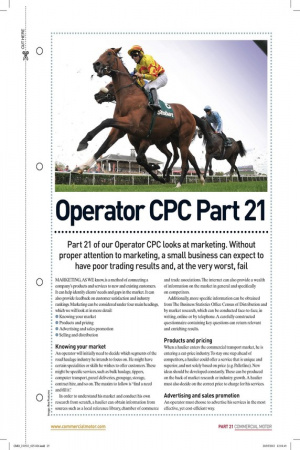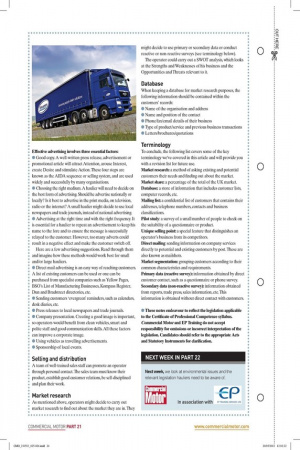Operator CPC Part 21 Part 21 of our Operator CPC
Page 19

Page 20

If you've noticed an error in this article please click here to report it so we can fix it.
looks at marketing. Without proper attention to marketing, a small business can expect to have poor trading results and, at the very worst, fail MARKETING, AS WE know, is a method of connecting a company's products and services to new and existing customers. It can help identify clients' needs and gaps in the market. It can also provide feedback on customer satisfaction and industry rankings. Marketing can be considered under four main headings, which we will look at in more detail: • Knowing your market • Products and pricing • Advertising and sales promotion • Selling and distribution Knowing your market An operator will initially need to decide which segments of the road haulage industry he intends to focus on. He might have certain specialities or skills he wishes to offer customers. These might be specific services, such as bulk haulage, tippers, computer transport, parcel deliveries, groupage, storage, contract hire, and so on. The maxim to follow is "find a need and fill it'.'
In order to understand his market and conduct his own research from scratch, a haulier can obtain information from sources such as a local reference library, chamber of commerce and trade associations. The internet can also provide a wealth of information on the market in general and specifically on competitors.
Additionally, more specific information can be obtained from The Business Statistics Office Census of Distribution and by market research, which can be conducted face-to-face, in writing, online or by telephone. A carefully constructed questionnaire containing key questions can return relevant and enriching results.
Products and pricing When a haulier enters the commercial transport market, he is entering a cut-price industry. To stay one step ahead of competitors, a haulier could offer a service that is unique and superior, and not solely based on price (e.g. Palletline). New ideas should be developed constantly. These can be produced on the back of market research or industry growth. A haulier must also decide on the correct price to charge for his services.
Advertising and sales promotion An operator must choose to advertise his services in the most effective, yet cost-efficient way. Effective advertising involves three essential factors: • Good copy. A well-written press release, advertisement or promotional article will attract Attention, arouse Interest, create Desire and stimulate Action. These four steps are known as the AIDA sequence or selling system, and are used widely and successfully by many organisations.
• Choosing the right medium. A haulier will need to decide on the best form of advertising. Should he advertise nationally or locally? Is it best to advertise in the print media, on television, radio or the internet? A small haulier might decide to use local newspapers and trade journals, instead of national advertising.
• Advertising at the right time and with the right frequency. It is essential for a haulier to repeat an advertisement to keep his name to the fore and to ensure the message is successfully relayed to the customer. However, too many adverts could result in a negative effect and make the customer switch off.
Here are a few advertising suggestions. Read through them and imagine how these methods would work best for small and/or large hauliers.
• Direct mail advertising is an easy way of reaching customers. A list of existing customers can be used or one can be purchased from specialist companies such as Yellow Pages, BSO's List of Manufacturing Businesses, Kompass Register, Dun and Bradstreet directories, etc.
• Sending customers 'evergreen' reminders, such as calendars, desk diaries, etc.
• Press releases to local newspapers and trade journals.
• Company presentation. Creating a good image is important, so operators would benefit from clean vehicles, smart and polite staff and good communication skills. All these factors can improve a corporate image.
• Using vehicles as travelling advertisements.
• Sponsorship of local events.
Selling and distribution A team of well-trained sales staff can promote an operator through personal contact. The sales team must know their product, establish good customer relations, be self-disciplined and plan their work.
Market research As mentioned above, operators might decide to carry out market research to find out about the market they are in. They might decide to use primary or secondary data or conduct reactive or non-reactive surveys (see terminology below).
The operator could carry out a SWOT analysis, which looks at the Strengths and Weaknesses of his business and the Opportunities and Threats relevant to it.
Database When keeping a database for market research purposes, the following information should be contained within the customers' records: • Name of the organisation and address Name and position of the contact • Phone/fax/email details of their business • Type of product/service and previous business transactions • Letters/brochures/quotations Terminology To conclude, the following list covers some of the key terminology we've covered in this article and will provide you with a revision list for future use.
Market research: a method of asking existing and potential customers their needs and finding out about the market. Market share: a percentage of the total of the UK market. Database: a store of information that includes customer lists, computer records, etc.
Mailing list: a confidential list of customers that contains their addresses, telephone numbers, contacts and business classifications.
Pilot study: a survey of a small number of people to check on the suitability of a questionnaire or product.
Unique selling point: a special feature that distinguishes an operator's business from its competitors.
Direct maffing: sending information on company services directly to potential and existing customers by post. These are also known as mailshots.
Market segmentation: grouping customers according to their common characteristics and requirements.
Primary data (reactive survey): information obtained by direct customer contact, such as a questionnaire or phone survey. Secondary data (non-reactive survey): information obtained from reports, trade press, sales information, etc. This information is obtained without direct contact with customers.
• These notes endeavour to reflect the legislation applicable to the Certificate of Professional Competence syllabus. Commercial Motor and EP Training do not accept responsibility for omissions or incorrect interpretation of the legislation. Candidates should refer to the appropriate Acts and Statutory Instruments for clarification.









































